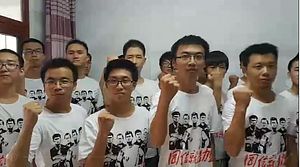Over the past several months, a number of student-activists have been seized and spirited away, presumably by security agents, on the campuses of several top-ranked universities in major Chinese cities. Those that disappeared recently participated in protests and other manifestations to support rural-to-urban migrant workers’ labor actions in manufacturing firms across southern China that produce consumer goods for the export market.
The Chinese government and Communist Party have always been wary of any opposition, although relatively tolerant of local-level dissent, provided the economy kept growing and that the targets of any contention were far below the top of the political hierarchy.
Today many factors have changed in ways that have given rise to a “perfect storm” of both activism and brute-force repression unlike anything China has seen in recent decades. Critical aspects of this round of cat-and-mouse diverge from past patterns in ways that portend greater strife in China’s future.
The new environment has produced a situation more volatile than anything we’ve seen in China in almost 30 years. University students are rediscovering Marx and Mao and taking their ideas seriously. Student activists are then making common cause and connecting with elements of the working class to an extent unimaginable since the days when workers manned barricades to defend students in 1989. And the state and Party have become remarkably less tolerant of even the mildest challenge or criticism.
Twenty years ago, when I first began studying labor and contentious politics in China, laid-off workers and pensioners from the country’s vast state-owned enterprise sector protested daily across hundreds of cities. They carried portraits of Chairman Mao and shouted slogans that recollected their youth spent as Red Guards or activists during the Cultural Revolution.
Ultimately, their claims were restorative and nostalgic. In Trump-like terms, they yearned to “make China communist again.” In the late 1990s, students at elite universities held rather different views. As new generation capitalist elites, they stood to gain much from further reform and, when they didn’t agree with the government or Party, they almost always wanted China to become a more cosmopolitan society and more thoroughly market economy. Workers migrating from the countryside to the city were exploited and regarded as second-class persons, much like undocumented immigrant workers in today’s America. But they soldiered on in tough conditions because the city still offered better opportunities than were available back in the village.
In 2008, the export-oriented model of economic development that had given China 15 years of remarkable growth buckled under the pressure of a global financial crisis and recession. Since then, every aspect of politics has shifted.
State enterprise workers and pensioners now enjoy much better benefits than before (with fewer being thrown out of work in first place). Rural-to-urban migrants have become cognizant and assertive of their rights as citizens, while increased labor market pressure has given them increasingly more leverage in pressing their claims.
Students, even at the best universities, now face much more difficulty finding decent employment after graduation and many have become disillusioned with the promises of an unbridled and globalized market. Finally, the Party-state under Xi Jinping has sought to restore the ideological legitimacy lost since the 1980s, while also ramping up its capacity for repression and social control to levels unseen since the 1950s. China’s leaders aim to shore up popular support, while also stamping out any possible opposition before it can pose any threat.
Migrant workers are partnering with radical students to frame and articulate their perspectives and claims in Maoist restorative idioms reminiscent of those formerly employed by state-sector workers. And the security apparatus is snatching students from campus, beating them, and bundling them into unmarked cars bound for harsh and lengthy detention, likely incommunicado, pending trial for potentially serious crimes — perhaps with a televised confession along the way. State sector workers, meanwhile, have stayed on the fence – or at least remained mostly quiet.
This is not a blip or one-off incident. It is, in Xi’s words, China’s “new normal.” The coming years are likely to see dramatically increasing contentious challenges to the Party from society. It is likely that new alliances will emerge among the challengers, as has happened with the workers and students. And the state is poised to continue with wave after wave of intemperate brute-force repression.
The entrenched conflict scenario that played out to bloody effect on June 4, 1989, could recur with alarming regularity and intensity over the years ahead. How Xi Jinping and the Party-state, on the one hand, and their critics, on the other, confront this challenge will determine their legacy, as well as China’s more immediate political fate. Already in the early stages of a crisis, the CCP’s regime will likely either emerge stronger, but as repressive as it was in its earliest days, or devolve and decay, potentially into collapse.
William Hurst is an associate professor of political science at Northwestern University and the author of “The Chinese Worker after Socialism” (Cambridge 2009) and “Ruling Before the Law” (Cambridge 2018).

































